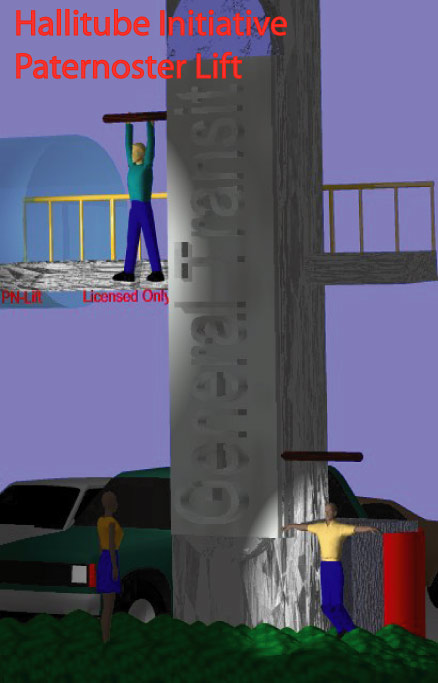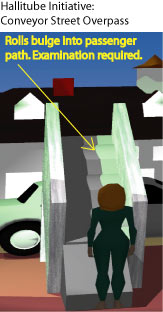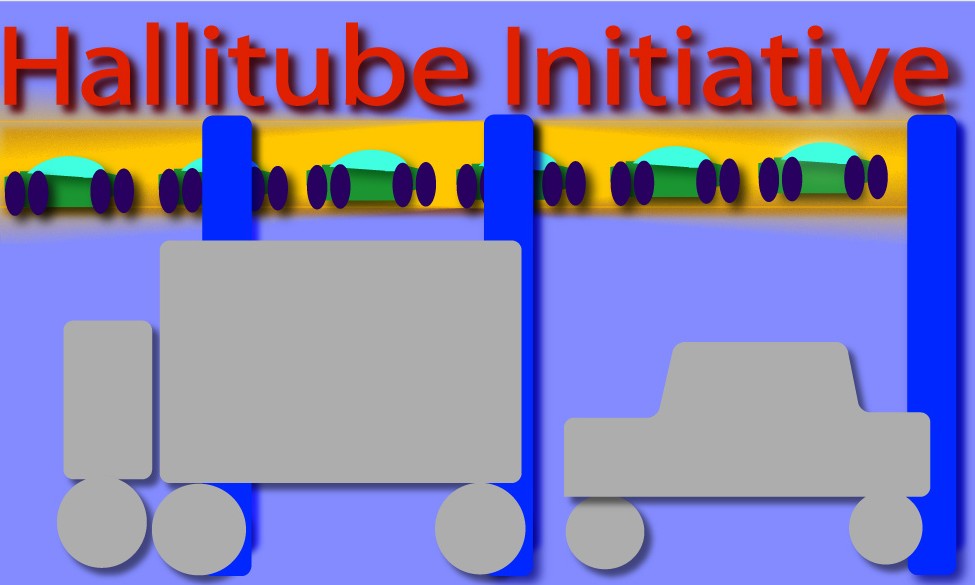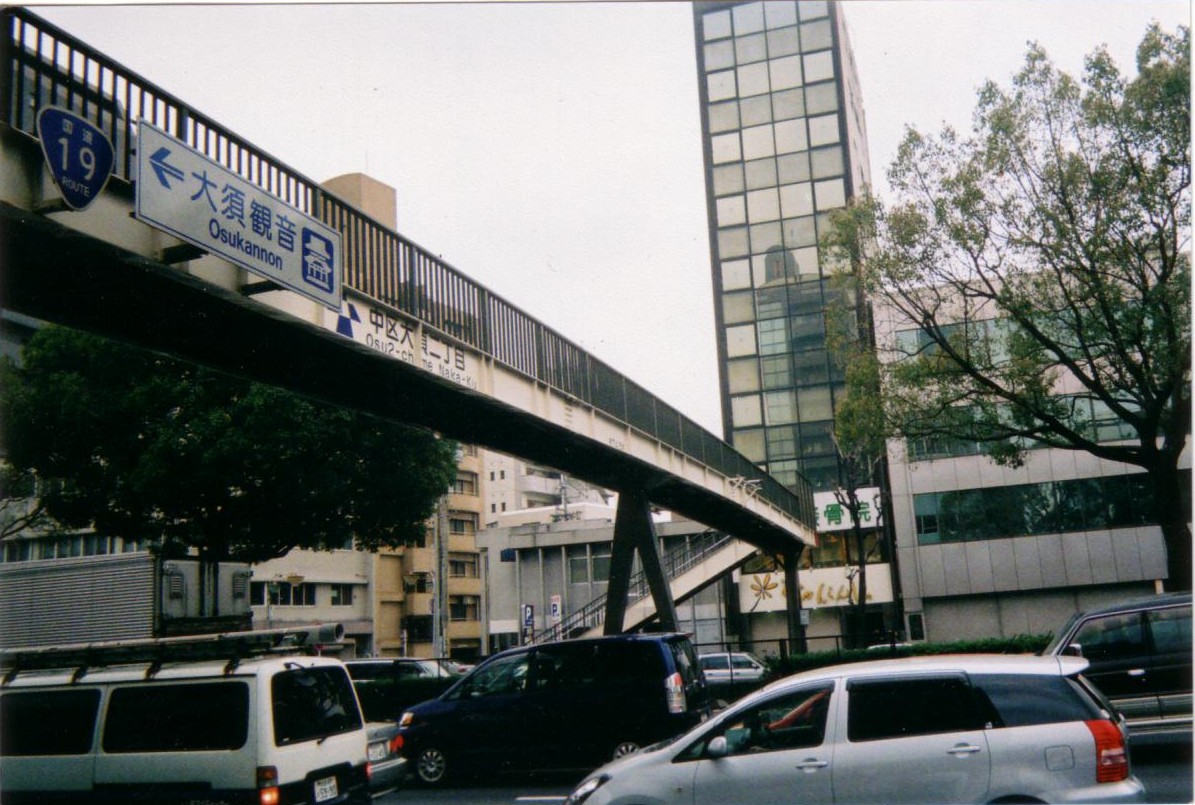Overpasses in the US are currently rare. Jaywalking
and traffic-halting foot passenger crossings bring city traffic to a crawl.
Asian countries have solved this only partially. By aggressively providing
gating around streets they limit crossing to over and underpasses which
do not inhibit traffic. But these are unpopular solutions, and expensive. Who wants to ascend
a stair and then walk down again with shopping bags just to cross a street
? And how are they built ? Most
unpopular solutions, and expensive. Who wants to ascend
a stair and then walk down again with shopping bags just to cross a street
? And how are they built ? Most  pedestrian overpasses could have four people walking side-by-side, and
yet they are deserted. Why the thickness ? The whole structure is safer.
Overpasses are the right solution, but not in the way we are building them
now, they are just not being used. And forcing their use would be highly
unpopular. Build automatic escalators into them ? Too expensive, because
we will need thousands and thousands, and escalators are complex systems
consisting of hundreds of parts. They break down frequently. Use
elevators ? Also too expensive, and people don't want to wait. What is left,
how do we get people up there cheaply ? By using the same approach
making Hallitubes possible : User skill dependent technology. We will
integrate a kevlar conveyor belt with the overpass, very similar to the expensive
people movers in airports. Except here, it is a tape, not a series of separate
pieces running in a rail, prone to breakdown while offering a smooth ride.
What is the downside of a conveyor belt ? Two disadvantages: the ride is
not smooth, and you will have to learn how to negotiate it without handholds.
When you get your driver's license, there will be an adjacent training
area. Yes, you have the skill to learn to ride a conveyor belt. Lesson
I is on anticipating the next roller: a conveyor belt is suspended on them,
at least in the cheap ones we need. Lesson II is on falling. Instead of
an expensive secondary structure with running armrests. like in an escalator,
the sides of the conveyor have a flexible netting/cushions functioning as
catch basket. During your license test you will have to drop into this netting
a few times, but soon you won't need it. Your stance is with feet separated,
standing almost sideways, with your knees flexed, to compensate for the slight
unevenness of the rollers.(Image shown does not use netting. We are currently
leaning to a design with armrests having a gel solution smeared on them.
This is cheap in reducing friction, most trained users will never touch
it. This way you cross the road quickly, and, yes, with shopping bags, it
is just a question of training. But even before the production of
mechanical overpasses, static overpasses need to be redesigned for
new construction to be thin and flexible, with width so that two people can
just squeeze by each other, using steel tubing. They need to become
minimalist bridges. The MOP when widely implemented will increase traffic
by about 10-15 mph. in cities. How often have you seen whole lines of cars
coming to a halt to let a pedestrian cross ?
pedestrian overpasses could have four people walking side-by-side, and
yet they are deserted. Why the thickness ? The whole structure is safer.
Overpasses are the right solution, but not in the way we are building them
now, they are just not being used. And forcing their use would be highly
unpopular. Build automatic escalators into them ? Too expensive, because
we will need thousands and thousands, and escalators are complex systems
consisting of hundreds of parts. They break down frequently. Use
elevators ? Also too expensive, and people don't want to wait. What is left,
how do we get people up there cheaply ? By using the same approach
making Hallitubes possible : User skill dependent technology. We will
integrate a kevlar conveyor belt with the overpass, very similar to the expensive
people movers in airports. Except here, it is a tape, not a series of separate
pieces running in a rail, prone to breakdown while offering a smooth ride.
What is the downside of a conveyor belt ? Two disadvantages: the ride is
not smooth, and you will have to learn how to negotiate it without handholds.
When you get your driver's license, there will be an adjacent training
area. Yes, you have the skill to learn to ride a conveyor belt. Lesson
I is on anticipating the next roller: a conveyor belt is suspended on them,
at least in the cheap ones we need. Lesson II is on falling. Instead of
an expensive secondary structure with running armrests. like in an escalator,
the sides of the conveyor have a flexible netting/cushions functioning as
catch basket. During your license test you will have to drop into this netting
a few times, but soon you won't need it. Your stance is with feet separated,
standing almost sideways, with your knees flexed, to compensate for the slight
unevenness of the rollers.(Image shown does not use netting. We are currently
leaning to a design with armrests having a gel solution smeared on them.
This is cheap in reducing friction, most trained users will never touch
it. This way you cross the road quickly, and, yes, with shopping bags, it
is just a question of training. But even before the production of
mechanical overpasses, static overpasses need to be redesigned for
new construction to be thin and flexible, with width so that two people can
just squeeze by each other, using steel tubing. They need to become
minimalist bridges. The MOP when widely implemented will increase traffic
by about 10-15 mph. in cities. How often have you seen whole lines of cars
coming to a halt to let a pedestrian cross ?
|
 unpopular solutions, and expensive. Who wants to ascend
a stair and then walk down again with shopping bags just to cross a street
? And how are they built ? Most
unpopular solutions, and expensive. Who wants to ascend
a stair and then walk down again with shopping bags just to cross a street
? And how are they built ? Most  pedestrian overpasses could have four people walking side-by-side, and
yet they are deserted. Why the thickness ? The whole structure is safer.
Overpasses are the right solution, but not in the way we are building them
now, they are just not being used. And forcing their use would be highly
unpopular. Build automatic escalators into them ? Too expensive, because
we will need thousands and thousands, and escalators are complex systems
consisting of hundreds of parts. They break down frequently. Use
elevators ? Also too expensive, and people don't want to wait. What is left,
how do we get people up there cheaply ? By using the same approach
making Hallitubes possible : User skill dependent technology. We will
integrate a kevlar conveyor belt with the overpass, very similar to the expensive
people movers in airports. Except here, it is a tape, not a series of separate
pieces running in a rail, prone to breakdown while offering a smooth ride.
What is the downside of a conveyor belt ? Two disadvantages: the ride is
not smooth, and you will have to learn how to negotiate it without handholds.
When you get your driver's license, there will be an adjacent training
area. Yes, you have the skill to learn to ride a conveyor belt. Lesson
I is on anticipating the next roller: a conveyor belt is suspended on them,
at least in the cheap ones we need. Lesson II is on falling. Instead of
an expensive secondary structure with running armrests. like in an escalator,
the sides of the conveyor have a flexible netting/cushions functioning as
catch basket. During your license test you will have to drop into this netting
a few times, but soon you won't need it. Your stance is with feet separated,
standing almost sideways, with your knees flexed, to compensate for the slight
unevenness of the rollers.(Image shown does not use netting. We are currently
leaning to a design with armrests having a gel solution smeared on them.
This is cheap in reducing friction, most trained users will never touch
it. This way you cross the road quickly, and, yes, with shopping bags, it
is just a question of training. But even before the production of
mechanical overpasses, static overpasses need to be redesigned for
new construction to be thin and flexible, with width so that two people can
just squeeze by each other, using steel tubing. They need to become
minimalist bridges. The MOP when widely implemented will increase traffic
by about 10-15 mph. in cities. How often have you seen whole lines of cars
coming to a halt to let a pedestrian cross ?
pedestrian overpasses could have four people walking side-by-side, and
yet they are deserted. Why the thickness ? The whole structure is safer.
Overpasses are the right solution, but not in the way we are building them
now, they are just not being used. And forcing their use would be highly
unpopular. Build automatic escalators into them ? Too expensive, because
we will need thousands and thousands, and escalators are complex systems
consisting of hundreds of parts. They break down frequently. Use
elevators ? Also too expensive, and people don't want to wait. What is left,
how do we get people up there cheaply ? By using the same approach
making Hallitubes possible : User skill dependent technology. We will
integrate a kevlar conveyor belt with the overpass, very similar to the expensive
people movers in airports. Except here, it is a tape, not a series of separate
pieces running in a rail, prone to breakdown while offering a smooth ride.
What is the downside of a conveyor belt ? Two disadvantages: the ride is
not smooth, and you will have to learn how to negotiate it without handholds.
When you get your driver's license, there will be an adjacent training
area. Yes, you have the skill to learn to ride a conveyor belt. Lesson
I is on anticipating the next roller: a conveyor belt is suspended on them,
at least in the cheap ones we need. Lesson II is on falling. Instead of
an expensive secondary structure with running armrests. like in an escalator,
the sides of the conveyor have a flexible netting/cushions functioning as
catch basket. During your license test you will have to drop into this netting
a few times, but soon you won't need it. Your stance is with feet separated,
standing almost sideways, with your knees flexed, to compensate for the slight
unevenness of the rollers.(Image shown does not use netting. We are currently
leaning to a design with armrests having a gel solution smeared on them.
This is cheap in reducing friction, most trained users will never touch
it. This way you cross the road quickly, and, yes, with shopping bags, it
is just a question of training. But even before the production of
mechanical overpasses, static overpasses need to be redesigned for
new construction to be thin and flexible, with width so that two people can
just squeeze by each other, using steel tubing. They need to become
minimalist bridges. The MOP when widely implemented will increase traffic
by about 10-15 mph. in cities. How often have you seen whole lines of cars
coming to a halt to let a pedestrian cross ?

